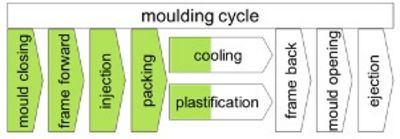General Information Design Principles - Conciseness
Designing the information interface refers to modalities (e.g., visual, auditory, haptic), objects (e.g., text, graphic, list, display) and may be passive or active (e.g., label, control, feedback). It is closely linked to human information processing as it influences reasoning and decision making while directly linking to perception (ascribe meaning) and action implementation (feedback).
Information presentation supports information flow by guiding the operators in a direction.
Among the interaction interface design requirements, the indicated requirement is presented in detailed below.
- Detectability
- Conciseness
- Coherence
- Discriminability
- Clearness
- Consistency
- Distraction free
- Legibility
Among the information interface design requirements "Conciseness" is important to allow the operator to perform his/her task.
Steps in moulding are supported by gaze flow in horizontal sequence representing the production process within the machine.
Concise information presentation is reduced to presentation of necessary information only and is supported by minimalism, simplicity, task relevance etc.
The Figure shows batch procedure of injection moulding machine that guides operators gaze horizontally from start to finish.
References
- EN 894-1 (2010). Safety of machinery – Ergonomics requirements for the design of displays and control actuators – Part 1: General principles for human interactions with displays and control actuators. Brussels: CEN.
- EN 894-4 (2010). Safety of machinery – Ergonomics requirements for the design of displays and control actuators – Control actuators – Part 4: Location and arrangement of displays and control actuators. Brussels: CEN.
- EN ISO 9241-112 (2017). Ergonomics of human-system interaction – Part 112: Principles for the presentation of information. Brussels: CEN
- Kantowitz, B.H., Sorkin, R.D. (1983). Human factors: Understanding people-system relationships. Wiley, New York.
- Wickens, C.D., Hollands, J.G., Banbury, S., Parasuraman, R. (2013). Engineering Psychology and Human Performance. Pearson, Upper Saddle River.


